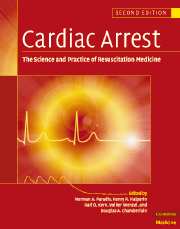Book contents
- Frontmatter
- Contents
- List of contributors
- Foreword
- Preface
- Part I Introduction
- Part II Basic science
- Part III The pathophysiology of global ischemia and reperfusion
- Part IV Therapy of sudden death
- 23 Prevention of sudden cardiac death
- 24 Sequence of therapies during resuscitation: application of CPR
- 25 Transthoracic defibrillation
- 26 Automated external defibrillators
- 27 Public access defibrillation
- 28 The physiology of ventilation during cardiac arrest and other low blood flow states
- 29 Airway techniques and airway devices
- 30 Manual cardiopulmonary resuscitation techniques
- 31 Mechanical devices for cardiopulmonary resuscitation
- 32 Invasive reperfusion techniques
- 33 Routes of drug administration
- 34 Adrenergic agonists
- 35 Vasopressin and other non-adrenergic vasopressors
- 36 Antiarrhythmic therapy during cardiac arrest and resuscitation
- 37 Acid–base considerations and buffer therapy
- 38 Cardiac arrest resuscitation monitoring
- 39 Special considerations in the therapy of non-fibrillatory cardiac arrest
- 40 Cardiocerebral resuscitation: a new approach to out-of-hospital cardiac arrest
- 41 Thrombolysis during resuscitation from cardiac arrest
- 42 Percutaneous coronary intervention (PCI) after successful reestablishment of spontaneous circulation and during cardiopulmonary resuscitation
- 43 Emergency medical services systems and out-of-hospital cardiac arrest
- 44 In-hospital resuscitation
- 45 Complications of CPR
- 46 Bringing it all together: state-of-the-art therapy for cardiac arrest
- Part V Postresuscitation disease and its care
- Part VI Special resuscitation circumstances
- Part VII Special issues in resuscitation
- Index
31 - Mechanical devices for cardiopulmonary resuscitation
from Part IV - Therapy of sudden death
Published online by Cambridge University Press: 06 January 2010
- Frontmatter
- Contents
- List of contributors
- Foreword
- Preface
- Part I Introduction
- Part II Basic science
- Part III The pathophysiology of global ischemia and reperfusion
- Part IV Therapy of sudden death
- 23 Prevention of sudden cardiac death
- 24 Sequence of therapies during resuscitation: application of CPR
- 25 Transthoracic defibrillation
- 26 Automated external defibrillators
- 27 Public access defibrillation
- 28 The physiology of ventilation during cardiac arrest and other low blood flow states
- 29 Airway techniques and airway devices
- 30 Manual cardiopulmonary resuscitation techniques
- 31 Mechanical devices for cardiopulmonary resuscitation
- 32 Invasive reperfusion techniques
- 33 Routes of drug administration
- 34 Adrenergic agonists
- 35 Vasopressin and other non-adrenergic vasopressors
- 36 Antiarrhythmic therapy during cardiac arrest and resuscitation
- 37 Acid–base considerations and buffer therapy
- 38 Cardiac arrest resuscitation monitoring
- 39 Special considerations in the therapy of non-fibrillatory cardiac arrest
- 40 Cardiocerebral resuscitation: a new approach to out-of-hospital cardiac arrest
- 41 Thrombolysis during resuscitation from cardiac arrest
- 42 Percutaneous coronary intervention (PCI) after successful reestablishment of spontaneous circulation and during cardiopulmonary resuscitation
- 43 Emergency medical services systems and out-of-hospital cardiac arrest
- 44 In-hospital resuscitation
- 45 Complications of CPR
- 46 Bringing it all together: state-of-the-art therapy for cardiac arrest
- Part V Postresuscitation disease and its care
- Part VI Special resuscitation circumstances
- Part VII Special issues in resuscitation
- Index
Summary
The rhythmic application of force to the body of the patient is fundamental to the process of generating blood flow in CPR, but there is little agreement as to the optimal technique for applying that force. There is a great need for improved external chest compression techniques since only an average of 5%–15% of patients treated with standard CPR survive cardiac arrest, and it is widely agreed that increasing the blood flow generated by chest compression will improve survival. Given the potential importance of newer devices and techniques that may augment blood flow, this chapter will explore several alternate devices and techniques that have been studied.
Piston chest compression
According to the most recently published guidelines of the Emergency Cardiac Care Committee of the American Heart Association, external chest compressions are applied by the rescuer who places the hands over the victim 's sternum. Force is applied straight down with the rescuer 's elbows locked and the shoulders in line with the hands. The goal is to displace the sternum 1 1/2 to 2 inches for an averagesized adult victim, 100 times per minute, with compression maintained for 50% of each cycle. Unfortunately, compressions are often done incorrectly, and incorrect chest compression can compromise survival. One way of improving the quality of chest compression is with automatic mechanical devices, which can potentially apply compression more consistently than by manual compression. Another way of potentially improving the quality of chest compression is to use gauges that provide feedback to the rescuer on the depth and rate of compressions, allowing the rescuer to adjust the application of force to produce compressions that have the correct depth and rate.
- Type
- Chapter
- Information
- Cardiac ArrestThe Science and Practice of Resuscitation Medicine, pp. 585 - 599Publisher: Cambridge University PressPrint publication year: 2007

